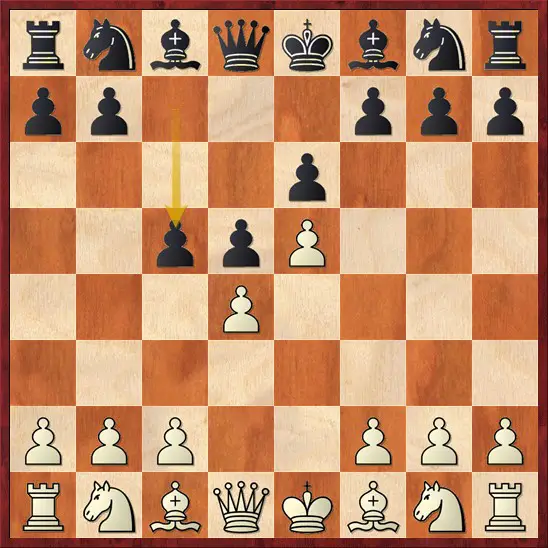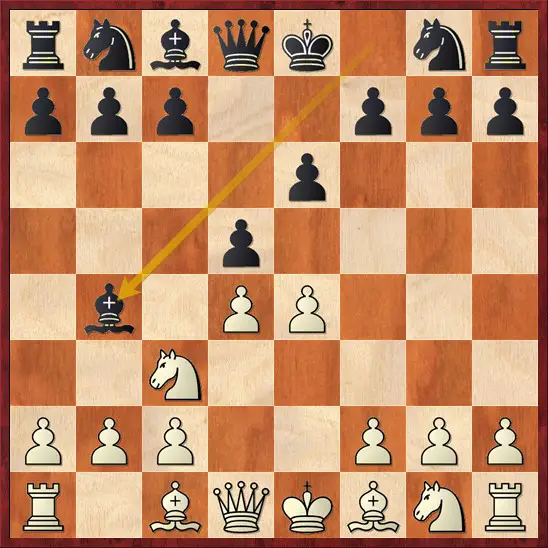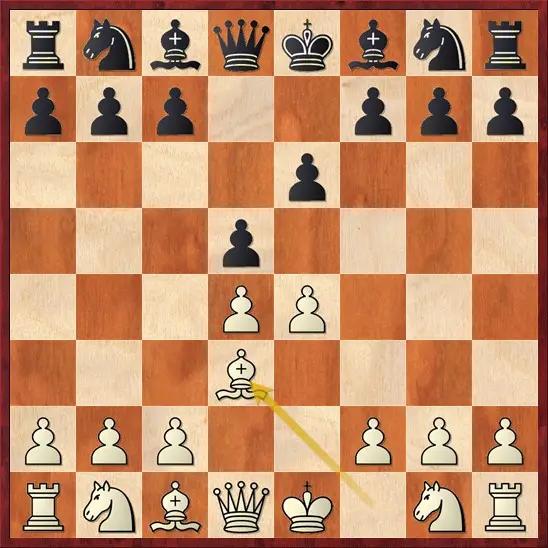The French defense arises after 1.e4 e6, is a sound positional response to 1.e4 which aims to construct a firm foothold in the centre with 2…d5. It has been used by many strong players of the past such as Mikhail Botvinnik and Viktor Korchnoi.

In French Defense, black gives white a lot of space and then aims to attack white’s pawn chain from its base. The only problem in this variation for black is the development of his c8 bishop. If he is able to solve the problem of his c8 bishop, he stands fine.
The main variations in French Defense are:
- The Exchange Variation
- The Advance Variation
- The Tarrasch Variation
- The Winawer Variation
- The Classical Variation
- The Rubinstein Variation
Let’s look at each one in detailed
French Defense Variations:
1. The Exchange Variation
The exchange variation starts after 1.e4 e6 2.d4 d5 3.exd5 exd5. It is supposed to be played when white aims for a draw as there is only one open file available for both the players (the e-file). All the heavy pieces get exchanged on this file, and the resulting position is very drawish.

The line goes 1.e4 e6 2.d4 d5 3.exd5 exd5 4.Bd3 Bd6 5.Nf3 Nf6 6.0-0 0-0 7.c4 c6 . Ther are many variations, this is just one of the most common positions that arises out of the French Exchange.
Black can also play for a win by continuing 4…c5 trying to imbalance the game with an IQP structure.
2. The Advance Variation:
The advance variation is more complex and can lead to sharp positions. It arises after the move order 1.e4 e6 2.d4 d5 3.e5 c5. Black tries to attack white’s pawn centre with the move ….c5. The advance variation is an aggressive opening variation for black.
White tries for a kingside attack in this variation since the pawn on e5 controls the f6 square so black cannot put a night on that square to defend the kingside. Black on the other hand tries to create counterplay by attacking White’s pawn centre and in general the d4 pawn.

The main line goes 1.e4 e6 2.d4 d5 3.e5 c5 4.c3 Nc6 5.Nf3 Qb6 6.a3
White can also play 6.Be2 cxd4 7.cxd4 Nh6 . Black plans Nf5 to put pressure on the d4 pawn. White usually responds with 8.Bxh6 or b3 preparing Bb2.
6….c4 7.Nbd2 Na5 8.Be2 Bd7 9.0-0 Ne7. Here black tries to clamp down on the b3 square with ideas like Qc7,Nc8,Nb6,Ba4 etc.
6. Bd3 is a gambit line known as the Milner-Barry Gambit. The line goes 6…cxd4 7.cxd4 Bd7 (7…Nxd4 loses on the spot to 8.Nxd4 Qxd4 9.Bb5+) 8.0-0 Nxd4 9.Nxd4 Qxd4 10.Nc3 with an initiative for white in return for the pawn.
3. The Tarrasch Variation (Nd2 variation)
This is considered to be white’s soundest response against the French defence and is employed by players who like to start with a sound positional base.

Black has few rare responses against 3.Nd2 some of which are 3…Nc6 (the Guimard variation) and 3…Be7 (this is often employed by Alexander Morozevich ).
).
However, the main tries are 3…Nf6 and 3…c5.
The main line in the Nf6 move order goes 1.e4 e6 2.d4 d5 3.Nd2 Nf6 4.e5 Nfd7 5.Bd3 c5 6.c3 Nc6 7.Nge2 cxd4 8.cxd4 f6, black tries to free his pieces and open the f file with this move. 4…
The c5 move order goes 1.e4 e6 2.d4 d5 3.Nd2 c5 4.exd5 exd5 5.Ngf3 Nc6 6.Bb5 Bd6 7.dxc5 Bxc5
A position with IQP arises on the board with chances for both sides.
Black can also play 4….Qxd5 5.Ngf3 cxd4 6.Bc4 Qd6 7.0-0 Nf6 8.Nb3 Nc6 9.Nbxd4 Nxd4
The position is roughly equal.
4. The Winawer Variation:
The Winawer variation goes like 1.e4 e6 2.d4 d5 3.Nc3 Bb4. This is the starting position of the winawer variation. It is a highly complex variation where white has the bishop pair, and black aims to damage white’s pawn structure by taking on c3.

The main variation runs 4.e5 c5 5.a3 Bxc3+ 6.bxc3 Ne7 7.Qg4
White aims to attack g7 since black does not have his dark-squared bishop.
7…Qc7!
Black sacrifices a pawn on the queenside for rapid development and to open lines.
8.Qxg7 Rg8 9.Qxh7 cxd4 10.Nge2
10.cxd4 runs into 10…Qc3+
10…Nc6 11.f4 dxc3 12.Qd3
Now black has two moves 12…d4 and 12.Bd7 and a highly complex battle await.
5. The Classical Variation
In the classical variation of the French defence, Black meets White’s 3.Nc3 by putting more pressure on the e4 pawn with 3…Nf6. Then white can continue with 4.e5 (the Steinitz variation) or 4.Bg5.
Classical Steinitz Variation:

1.e4 e6 2.d4 d5 3.Nc3 Nf6 4.e5
White gains space and pushes black’s night to a less active square. This variation is named after Wilhelm Steinitz and continues with 4…Nfd7. Here white has 5.Nce2 (the Shirov-anand variation) and 5.f4 (the mainline of the Steinitz).
The mainline goes 5.f4 c5 6.Nf3 Nc6 7.Be3. Here there are three moves 7…cxd4, a6 and 7…Be7 all leading to interesting positions with black.
The Classical Burn Variation:
This is named after Amos Burn and is very common at the top level.
The line goes 1.e4 e6 2.d4 d5 3.Nc3 Nf6 4.Bg5 White pins the night and plans e5 next.

4…dxe4 5.Nxe4 Be7 6.Bxf6 Bxf6 (6….gxf6 can also be played which aims to create a counterplay down the g file).
Classical Mainline:
This was the most popular line until recently the Burn variation has overtaken its popularity.
1.e4 e6 2.d4 d5 3.Nc3 Nf6 4.Bg5 Be7 5.e5 Nfd7 6.Bxe7
6.h4 is another continuation known as the Alekhine-Chatard attack. The line runs 6…Bxg5 7.hxg5 Qxg5 8.Nh3 Qe7 9.Qg4 g6 10.Ng5. White sacrifices a pawn for rapid development.
6…Qxe7 7.f4 0-0 8.Nf3 c5 when white has a number of choices between 9.Bd3, Qd2 and dxc5.
The Mccutcheon Variation
This is a very fighting variation that black uses to imbalance the game from a very early stage. The line runs 1.e4 e6 2.d4 d5 3.Nc3 Nf6 4.Bg5 Bb4 5.e5 h6!
Black counterattacks in an innovative way!

6.Bd2 Bxc3 7.bxc3 Ne4 8.Qg4
Here black has 8…g6 and 8…Kf8.
6. The Rubinstein Variation:
This variation is named after the famous Akiba Rubinstein. It arises after 1.e4 e6 2.d4 d5 3.Nc3 dxe4
Black avoids being pushed back and aims for an open game. Today few German grandmasters like Georg Meier use this variation frequently.

The variation goes 4.Nxe4 Nd7 (intending Ngf6) 5.Nf3 Ngf6 6.Nxf6+ Nxf6 when black plans to free his game with a later ….c5. This variation is played by players who like to play the endgame!
Some rare variations from white:
The Chigorin Variation:

This line discourages black from playing 2…d5 as white wins a pawn with 3.exd5. So black plays 2…c5 which can later transpose into some kind of Sicilian structure.
The two nights variation:
1.e4 e6 2.Nf3 d5 3.Nc3
This variation is popular at the club level. 3…d4 and 3…Nf6 are the main replies by black.

The King’s Indian Attack:
This is another setup that is used by players of all levels including those at the very elite.
White plays the setup 1.e4 e6 2.d3 d5 3.Nd2, then he plays Ngf3,g3,Bg2,0-0.c3 and Re1 and plans to attack black on the kingside.

The mainline runs:
1.e4 e6 2.d3 d5 3.Nd2 Nf6 4.Ngf3 c5 5.g3 Nc6 6.Bg2 Be7 7.0-0 0-0 8.e5 Nd7 9.Re1. Here black has 9…Qc7 and 9…b5.
The Sclechter Variation:
This variation is named after Carl Sclechter and is a new way to take French players out of their comfort zone.

Black generally answers 3.Bd3 with 3…c5 or 3…dxe4 after which the game takes an open character.
